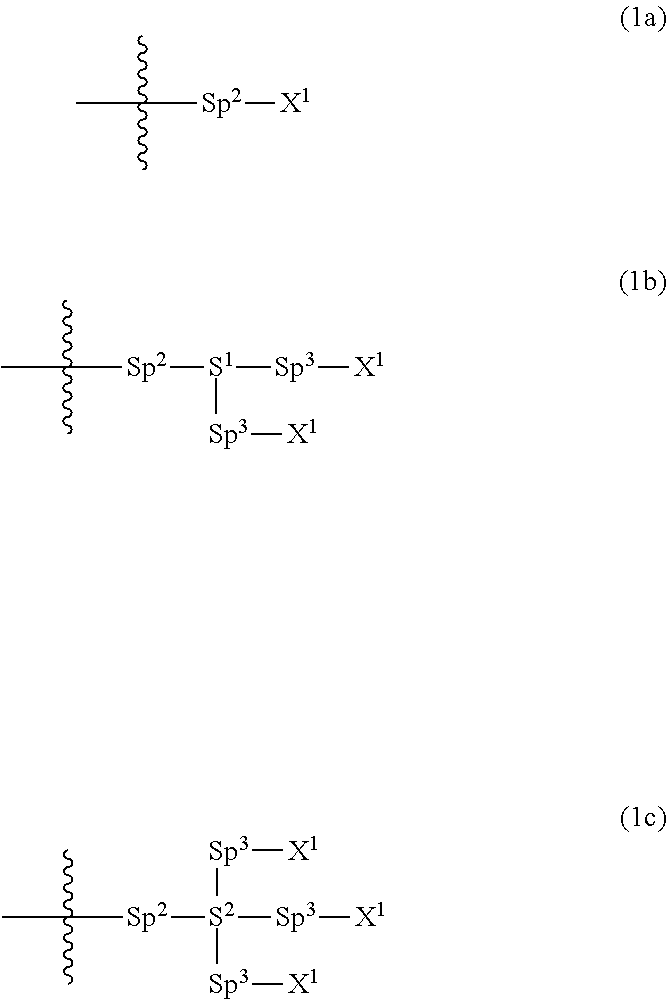Polymerizable polar compound, liquid crystal composition, and liquid crystal display element
- Summary
- Abstract
- Description
- Claims
- Application Information
AI Technical Summary
Benefits of technology
Problems solved by technology
Method used
Image
Examples
synthesis example 1
Synthesis of Compound (1-4-2)
[0251]
First Step
[0252]Compound (T-1) (25.0 g), acrylic acid (7.14 g), DMAP (1.21 g) and dichloromethane (300 mL) were put in a reaction vessel, and the resulting mixture was cooled down to 0° C. Thereto, a dichloromethane (125 mL) solution of DCC (24.5 g) was slowly added dropwise, and the resulting mixture was stirred for 12 hours while returning to room temperature. An insoluble matter was filtered off, and then the resulting reaction mixture was poured into water, and an aqueous layer was subjected to extraction with dichloromethane. A combined organic layer was washed with water, and dried over anhydrous magnesium sulfate. The resulting solution was concentrated under reduced pressure, and the residue was purified by silica gel chromatography (heptane:toluene=2:1 in a volume ratio). The residue was further purified by recrystallization from Solmix (registered trade name) A-11 to obtain compound (T-2) (11.6 g; 380).
Second Step
[0253]Paraformaldehyde (2...
synthesis example 2
Synthesis of Compound (1-4-22)
[0258]
First Step
[0259]Compound (T-4) (42.5 g; 65%) was obtained by using compound (T-3) (50.0 g) as a raw material in a manner similar to the procedures in the second step in Synthesis Example 1.
Second Step
[0260]Compound (T-4) (42.5 g), imidazole (24.5 g) and dichloromethane (740 mL) were put in a reaction vessel, and the resulting mixture was cooled down to 0° C. Thereto, a dichloromethane (110 mL) solution of t-butyldimethylsilyl chloride (54.1 g) was slowly added dropwise, and stirred for 12 hours while returning to room temperature. The resulting reaction mixture was poured into water, and an aqueous layer was subjected to extraction with dichloromethane. A combined organic layer was washed with water, and dried over anhydrous magnesium sulfate. The resulting solution was concentrated under reduced pressure, and the residue was purified by silica gel chromatography (heptane:ethyl acetate=10:1 in a volume ratio) to obtain compound (T-5) (79.8 g; 100%...
synthesis example 3
Synthesis of Compound (1-4-27)
[0268]
First Step
[0269]Compound (T-7) (4.00 g), potassium carbonate (4.49 g), tetrabutylammonium bromide (TBAB) (1.05 g) and DMF (60 mL) were put in a reaction vessel, and the resulting mixture was stirred at 80° C. for 1 hour. Thereto, a DMF (20 mL) solution of compound (T-9) (5.27 g) prepared according to a technique described in JP 2011-21118 A was slowly added dropwise, and further stirred at 80° C. for 2 hours. The resulting reaction mixture was poured into water, and an aqueous layer was subjected to extraction with ethyl acetate. A combined organic layer was washed with water, and dried over anhydrous magnesium sulfate. The resulting solution was concentrated under reduced pressure, and the residue was purified by silica gel chromatography (heptane:toluene=2:1 in a volume ratio) to obtain compound (T-10) (4.00 g; 72%).
Second Step
[0270]Compound (1-4-27) (1.81 g; 42%) was obtained by using compound (T-10) (4.00 g) as a raw material in a manner simil...
PUM
| Property | Measurement | Unit |
|---|---|---|
| Digital information | aaaaa | aaaaa |
| Fraction | aaaaa | aaaaa |
| Fraction | aaaaa | aaaaa |
Abstract
Description
Claims
Application Information
 Login to View More
Login to View More - R&D
- Intellectual Property
- Life Sciences
- Materials
- Tech Scout
- Unparalleled Data Quality
- Higher Quality Content
- 60% Fewer Hallucinations
Browse by: Latest US Patents, China's latest patents, Technical Efficacy Thesaurus, Application Domain, Technology Topic, Popular Technical Reports.
© 2025 PatSnap. All rights reserved.Legal|Privacy policy|Modern Slavery Act Transparency Statement|Sitemap|About US| Contact US: help@patsnap.com



